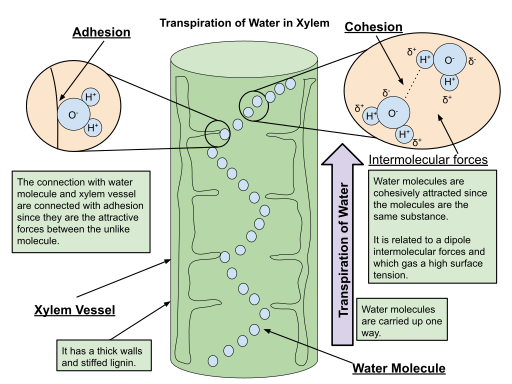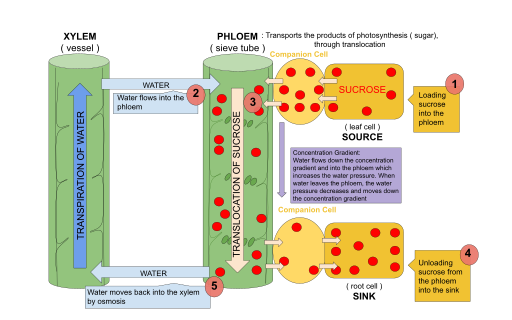OCR Specification focus:
‘As plants increase in size and complexity, transport systems are needed to deliver resources and remove wastes, given low SA:V and metabolic demands of tissues.’
Multicellular plants require efficient transport systems to distribute water, minerals and assimilates across large distances, overcoming diffusion limitations and supporting metabolic activity in specialised tissues.
The Need for Transport Systems in Plants
As plants grow larger and more complex, they consist of millions of cells organised into specialised tissues and organs. Simple diffusion becomes insufficient to meet the metabolic demands of all cells, especially those far from resource exchange surfaces such as roots and leaves. Therefore, transport systems are essential for efficient internal movement of materials.
Surface Area to Volume Ratio (SA:V)
Small, unicellular organisms have a high surface area to volume ratio, meaning that diffusion alone can supply all necessary materials and remove wastes rapidly. In contrast, large multicellular plants possess a low SA:V, reducing the efficiency of diffusion over long distances.
A low SA:V means:
Less surface area available for exchange relative to the plant’s volume.
Slower diffusion rates to internal tissues.
Necessity for specialised structures to transport materials effectively.
Substances That Need Transport
Water and Mineral Ions
Water is vital for maintaining cell turgor, photosynthesis, and transport of dissolved minerals. Minerals such as nitrates, phosphates, and magnesium ions are required for growth, nucleic acid synthesis and chlorophyll production.
Assimilates
Assimilates (e.g., sucrose, amino acids) are organic molecules produced during photosynthesis that must be transported from sources (photosynthetic tissues) to sinks (growing or storage tissues).
Hormones and Signalling Molecules
Plants produce hormones such as auxins, cytokinins, and abscisic acid. These are transported to regulate growth, development, and responses to environmental stimuli.
Waste Products
Although plants produce fewer metabolic wastes than animals, substances such as oxygen (from photosynthesis) and carbon dioxide (from respiration) must still diffuse efficiently to maintain homeostasis.
Diffusion and Its Limitations in Large Plants
Diffusion Distance
In small or simple plants like mosses, diffusion is sufficient because all cells are close to the environment. However, as plants evolve thicker tissues and more extensive structures, diffusion distances increase.
Long diffusion distances cause:
Slow delivery of essential substances.
Accumulation of waste products.
Inability to maintain metabolic activity in internal cells.
Diffusion: The passive movement of particles from an area of higher concentration to an area of lower concentration, down a concentration gradient.
Thus, larger plants require internal transport systems to overcome the limitations of diffusion alone.
The Roles of Plant Transport Systems
Transport of Water and Minerals – The Xylem
The xylem is the main tissue responsible for transporting water and dissolved minerals from the roots to the aerial parts of the plant.
Key characteristics of xylem:
Composed of dead, hollow cells forming continuous tubes.
Strengthened with lignin, providing structural support.
Transport driven by transpiration pull, root pressure, and capillarity.
Water moves upwards unidirectionally due to cohesion between water molecules and adhesion to the vessel walls.

Diagram of xylem transport driven by transpiration, highlighting the continuous water column and upward movement from roots to leaves. The image reinforces unidirectional flow and the role of cohesion/adhesion. Content aligns with OCR scope; no extra mechanisms beyond syllabus essentials are shown. Source.
Water moves upwards unidirectionally due to cohesion between water molecules and adhesion to the vessel walls. This allows water to reach even the highest leaves of tall trees.
Transport of Organic Substances – The Phloem
The phloem transports organic nutrients, particularly sucrose, from sources (e.g., leaves) to sinks (e.g., roots, fruits, or storage organs). Unlike xylem, phloem transport is bidirectional, enabling distribution based on metabolic demand.

A labelled overview of phloem translocation, showing sucrose loading at a source, pressure-driven bulk flow along sieve tubes, and unloading at a sink. Note how water enters from xylem near the source and exits near the sink to maintain the pressure gradient. This diagram includes only core features required at OCR A-level. Source.
Translocation: The movement of assimilates, primarily sucrose, through the phloem from sources to sinks.
Phloem tissue includes:
Sieve tube elements, which form channels for flow.
Companion cells, which provide metabolic support and energy for active transport.
Plasmodesmata, connecting the cytoplasm of adjacent cells for efficient exchange.
Metabolic Demands of Tissues
Photosynthetic Tissues
Leaves, as major sites of photosynthesis, produce glucose that must be transported to other parts of the plant for growth or storage. These tissues also require water and carbon dioxide for sustained activity.
Non-Photosynthetic Tissues
Roots, flowers, and developing fruits are non-photosynthetic and rely on transported assimilates for energy and biosynthesis. The demand for nutrients in these tissues further highlights the necessity of efficient transport systems.
Active Tissues
Regions of rapid growth such as meristems have high metabolic rates. They require a constant supply of oxygen, water, and nutrients, which diffusion alone cannot provide.
Pathways of Transport
Water and Mineral Transport
Root uptake: Water enters through root hair cells by osmosis, while minerals are absorbed via active transport.
Movement to xylem: Water travels through the apoplast (cell wall) or symplast (cytoplasm via plasmodesmata) pathways.
Ascent of xylem sap: Driven by transpiration and cohesive forces within the xylem column.
Assimilate Transport
Loading of sucrose into phloem companion cells requires ATP, establishing a high concentration gradient.
Pressure flow mechanism drives sucrose movement from source to sink regions.
The Link Between Structure and Function
Plant transport systems are intricately linked to their structural adaptations:
Roots provide large surface area for absorption and anchorage.
Stems contain vascular bundles with xylem and phloem for vertical transport and support.
Leaves are structured to facilitate gas exchange and efficient loading/unloading of assimilates.
Vascular Bundle: A plant structure containing xylem and phloem tissues, responsible for the transport of water, minerals, and assimilates.
Each component contributes to maintaining internal balance and efficient distribution of materials necessary for survival, growth, and reproduction.
Summary of Key Reasons for Transport Systems
Low SA:V ratio reduces diffusion efficiency in large plants.
High metabolic demand requires rapid distribution of materials.
Specialisation of tissues increases interdependence between organs.
Environmental challenges, such as water scarcity, require regulated transport mechanisms.
Together, these factors demonstrate why multicellular plants need transport systems to sustain their complex structure and physiological functions.
FAQ
As plants grow taller and more complex, tissues such as bark and thick stems reduce the ability of gases and nutrients to diffuse through. The separation between photosynthetic leaves, absorbing roots, and reproductive organs increases.
Transport systems are therefore essential to connect these regions, allowing efficient movement of water, minerals, and sugars between specialised organs. Without them, internal tissues would become starved of essential resources and waste removal would be limited.
A low surface area to volume ratio means that only a small proportion of a plant’s outer surface is in contact with the environment compared to its total volume.
This restricts the rate at which water and minerals can enter by diffusion, especially in large roots or stems.
As a result, internal tissues depend on vascular systems to distribute absorbed water and nutrients rapidly to all parts of the plant.
Roots absorb water and mineral ions from the soil through root hairs, creating the initial input for the xylem stream.
Leaves, on the other hand, act as major sources of assimilates from photosynthesis, feeding the phloem system.
This division of labour ensures that:
Xylem moves substances from roots upward.
Phloem distributes organic products from leaves to non-photosynthetic tissues.
Together, they complete a two-way internal network that maintains metabolic balance.
Without a functioning phloem, the transport of sugars and amino acids from sources (leaves) to sinks (roots, fruits, or growing tissues) would stop.
Consequences include:
Energy starvation in non-photosynthetic tissues.
Stunted growth and failure of developing organs.
Accumulation of sugars in leaves, disrupting osmotic balance.
Even though water could still move through the xylem, the plant would eventually die due to lack of organic nutrient distribution.
Plant hormones such as auxins and cytokinins move through several routes:
In solution via the xylem or phloem with other substances.
Through diffusion between adjacent cells.
By active transport mechanisms involving membrane carriers.
This multi-pathway movement allows local and systemic signalling, coordinating growth responses such as phototropism, seed germination, and stress reactions without requiring a specialised endocrine system.
Practice Questions
Question 1 (2 marks)
Explain why diffusion alone is insufficient to meet the metabolic demands of large multicellular plants.
Mark scheme:
1 mark – States that diffusion is too slow over long distances in large plants.
1 mark – Mentions that cells deep within tissues are too far from exchange surfaces, so substances cannot reach them quickly enough to meet metabolic demands.
Question 2 (5 marks)
Describe how the xylem and phloem contribute to transport within a multicellular plant, and explain why both systems are necessary.
Mark scheme:
1 mark – Describes that xylem transports water and mineral ions from roots to leaves.
1 mark – States that phloem transports assimilates such as sucrose from sources (leaves) to sinks (roots, fruits).
1 mark – Mentions that xylem movement is unidirectional, driven by transpiration pull and cohesion/adhesion of water molecules.
1 mark – Notes that phloem transport is bidirectional, driven by active loading and pressure flow.
1 mark – Explains that both systems are necessary because diffusion alone cannot supply materials efficiently throughout large plants with low surface area to volume ratios.

